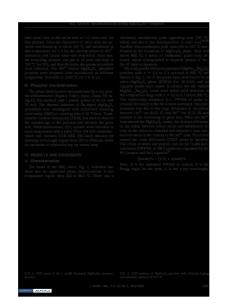Nanostructured Zinc Sulphide Phosphors
- PDF / 2,760,655 Bytes
- 6 Pages / 414.72 x 648 pts Page_size
- 42 Downloads / 383 Views
ABSTRACT Zinc sulphide (ZnS) particles are efficient phosphors for application in flat-panel displays. Spherical ZnS particles were prepared by precipitation from a homogeneous solution. Nanoparticles of 20 to 40 nm having a very narrow size distribution could be synthesized by using complexing chelates such as acetate and acetylacetonate. Complexing of the precipitating cation with the anions present in the system lead to a limited concentration of free cations in the solution. This strongly influences the kinetics of the primary particle agglomeration/growth, resulting in nanometer-sized ZnS particles. Nanostructured ZnS synthesized in this way are polycrystalline particles composed of crystallites of 5-10 nm. The synthesis of very small, non-agglomerated, nanocrystalline particles in the 5-10 nm size range was also possible, making use of a strong complexing ligand (thioglycerol) during the synthesis. The synthesis of controlled monosized ZnS particles will be presented and discussed. The photoluminescence characteristics of ZnS make this material a suitable candidate as phosphor for application in low voltage display technology. The effect of Mn 2÷ doping on the luminescence characteristics of ZnS will also be discussed.
INTRODUCTION The physical and chemical properties of semiconductor particles have been investigated as a
function of their size in many fields of science. In the case of ZnS, a size-dependence of the optical absorption has been observed [1, 2]. This results in a shifted absorption to higher energies due to size confinement effects. The reduction of the ZnS particle size to few nanometers induces a blue shift in the absorption spectra whereas doping ZnS with around 1-2 mol. % of Mn 2+ renders this material one of the most efficient phosphors [3, 4]. Narrower grain boundaries arising from smaller particle sizes will also lead to a decrease in the effective voltage necessary for electron injection, possibly allowing lower voltage operation of electroluminescent devices. Furthermore, a very narrow size distribution of the ZnS nanoparticles is needed to observe such phenomena. The preparation of zinc sulphide particles can be achieved various methods, including gasphase, solid-vapor and precipitation techniques [5, 6]. The precipitation of ZnS colloids starting from a homogeneous solution appeared a well-adapted method to obtain monodispersed particles [7]. This reaction involves the decomposition of thioacetamide (TAA), which generates the precipitating sulphur anions (S2-). The controlled release of such species is a key parameter for synthesizing uniform and monodispersed particles. An alternative to this method consists of adding chemical additives to control the agglomeration of the particles [8-10]. The present study concerns the synthesis of controlled size ZnS particles and the investigation of the luminescence efficiency with respect to the particle size, distribution and Mn 2÷doping. EXPERIMENTAL ZnS powders were prepared in aqueous solution under acidic pH conditions. The reaction was c
Data Loading...











